Once the excavation, survey, and architecture teams leave for work each day, the villages are for the most part transformed back into their usual sleepy selves. The sherd yard however, managed by registrar Leslie Hammond (pictured above with a feline friend) and assistants Sarah Linn and Sarah Beckman, becomes a bustling center of activity.
Not All Work And No Play
Each week, daily excavation and survey work takes a short hiatus on Saturday afternoons and Sundays. While weekends are certainly meant to be restful, they are also full of excursions, activities, and family-style meals at local Greek ‘tavernas.’
The 2010 Field Season Begins
The Summer 2010 Field Season began with the arrival of over 40 archaeologists, architects, surveyors and specialists to Mt. Lykaion on June 5th. The group, which will expand to over 60 people through the course of the summer, is a dynamic mix of experienced veterans and fresh faces.
After a three(ish) hour drive from the Athens airport, dinner prepared by cook Sam McBride at the Ano Karyes “dining palace,” and a full night’s rest, Wednesday morning began with an orientation to the site and project. See after the jump for pictures of the group preparing the lab and excavation equipment for use and the initial site tour.
Modern Lykaion Games
The tenth Modern Lykaion Games were held on Sunday August 9, 2009 in a beautiful mountain meadow high on the slopes of Mt. Lykaion in Arcadia at 1182 m (4000 feet) above sea level.
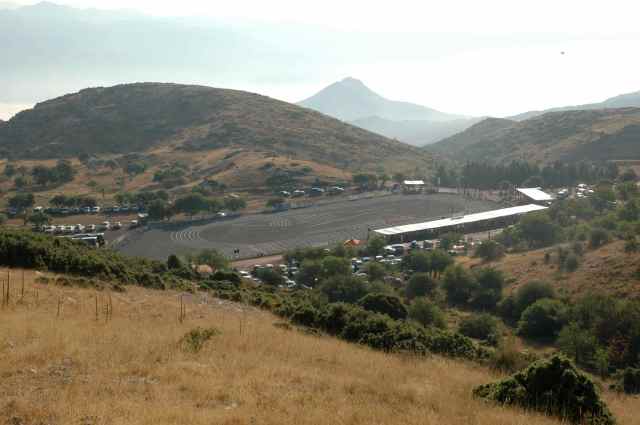
Site of the Lykaion Games, August 9, 2009
The ancient hippodrome and stadium of the ancient Lykaion Games is the site of the modern athletic festival that is hosted by the Syllogos of the village of Ano Karyes. The modern athletic festival is a recreation of the ancient athletic festival in honor of Zeus that was well known in antiquity from the Archaic, Classical and Hellenistic periods (ca. 700 – 100 B.C.).
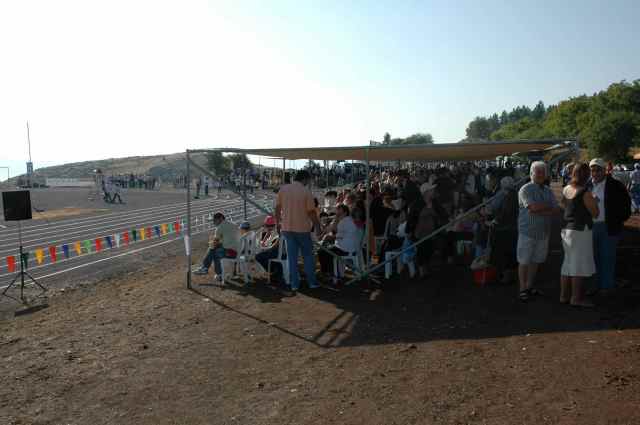
Spectators at the Lykaion Games 2009
The ancient games were held every four years and were likely to have been, in a number of senses, competition for the ancient Olympic Games (also in honor of Zeus) held at Olympia, some 22 miles to the northwest. The modern athletic festival at Mt. Lykaion, begun in 1973, is now a part of a nine-day regional and cultural festival in the area of Western Arcadia, Northern Messenia and Eastern Elis, that includes various cultural events including drama, theater, literature, film and music. The festival moves from village to town for nine days and nine nights. The final day is devoted to the athletic contests.


Poster for the Modern Lykaion Games

Sunday August 9 began at dawn at the southern peak of Mt. Lykaion, 1382 m. above sea level. Nine modern priestesses assembled at the Temenos of Zeus, to the accompaniment of rhythmic percussion, and brought with them a flame that was subsequently carried by means of several runners to the site of the athletic events on the hippodrome and stadium, some 200 m. below. A large group of spectators were on hand to watch the early morning ceremony. I was there as I had been in 2005 at the ninth Modern Lykaion Games.
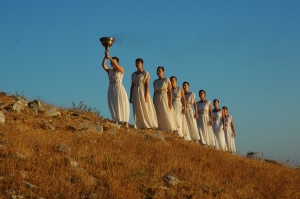
Modern Priestesses bringing the flame to the Temenos of Zeus
The runners brought the flame down to the hippodrome and stadium, the torch was used to light a large flame in a cauldron and the games began.
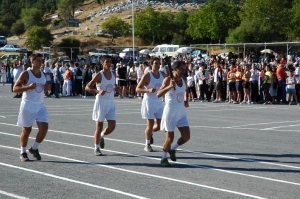
Flame brought to the track below the altar by Yanis Kouros, famous ultra-marathoner (2005 photo)
By this time there were hundreds of competitors at the modern track with well over 1,000 spectators lining the track and including village presidents, mayors and governors. Most of the hippodrome had been converted into the largest parking facility in Arcadia. Our excavations had ended several weeks previous to the Modern Lykaion Games but many of the trenches were visible for the spectators and interested visitors. This included the trenches at the ash altar of Zeus on the southern peak of the mountain. In addition to this our archaeological work as well as our proposal for the Parrhasian Heritage Park was highlighted in the brochure that was produced for the games.
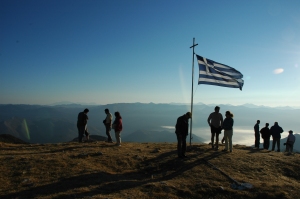
Ash Altar of Zeus on the morning of the Lykaion Games (2005 photo)
The track meet is sanctioned by the regional track and field authorities of the Peloponnesos and there are events for boys and girls, men and women and there are also Master’s events. The ancient hippodrome and stadium has been converted into a modern track by means of modern fill being brought in to cover the ancient surfaces. We know this because we have dug through this modern fill in four of our trenches. The games are unusual in the sense that there are no registration fees, no entry fees, no parking fees, and also according to ancient tradition there are no times or distances measured. There are banners at the site of the track that say very literally “The Lykaion Games are crown games and not money games.” The top three finishers in each event win crowns of leaves and a small bronze tripod (likely the prize in the ancient Lykaion Games.) During the course of the events there was a selection of ancient music presented.
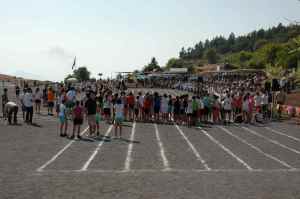
The Lykaion Games underway
The modern track is an oval, approximately 200 m. and the track and field events replicate some of those that are known to have been held in the ancient Lykaion Games, modified for the size of the track and the age of the competitors. We know about the events of the ancient games from a pair of victor inscriptions that have been found at the site. So for instance there is a STADION race of1/3 of a STADION (64 m.) for young children and ½ of a STADION (96 m.) for adolescents and the full STADION (192 m.) for older age groups; The DIAULOS (384 m.) for all age groups; the DOLICHOS (1344 m.) for all ages and also the long jump; weight throw; shot put.
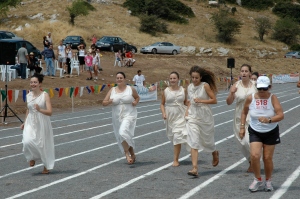
Priestesses on the move!
There is also the “Old Warriors” category for the Masters, those who are over 40 years of age. I fall into this category and I ran in the 1344 m. DOLICHOS. There were somewhere between 30-40 entries in the race and I would like to think that I finished somewhere in the middle of the pack. This was the second time that I had run in this event, having participated first in 2005.
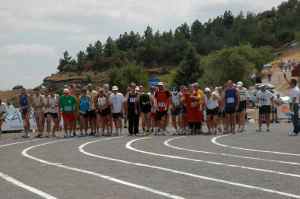
Old Warriors at the start
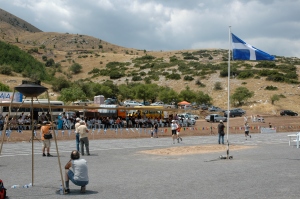
One Old Warrior finishing the race
The Modern Lykaion Games are sponsored by the Syllogos and Village of Ano Karyes, Arcadia. Christos Koumoundouros is the President of the Syllogos and it is he who, together with 22 residents of this tiny village and others, put together the organization of this remarkable track meet.
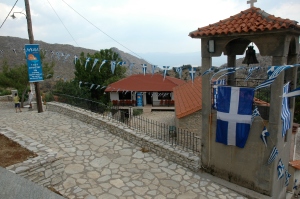
Village of Ano Karyes decorated for the Lykaion Games
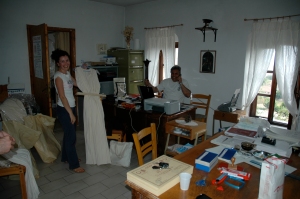
Christos Koumoundouros with a Priestess in the Lykaion Games Office
David Gilman Romano, Ph.D.
Field Director and Co-Director, Mt. Lykaion Excavation and Survey Project
For more information on the Ancient Lykaion Games see http://lykaionexcavation.org
Geology and Landscape
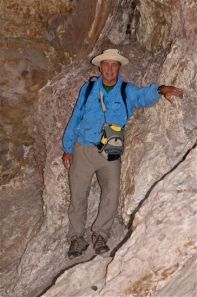
George Davis in a cave
This week I’ll introduce another exceptional team working at Mt. Lykaion: the geologists. It’s a team of just two—Dr. George Davis of the University of Arizona and his able assistant, Karl Yares—but they’ve managed to accomplish a tremendous amount over the course of the season. From field mapping the region to digitally processing all their data to digging their own trench, the geologists did a little of nearly everything.
As George helped us appreciate, the geology of Mt. Lykaion and its environs is incredible. Active faults zigzag across the land, and their traces are visible everywhere, at least with someone like George to help us notice them. In some places, compressional forces have caused a plane to fold back on itself in a hairpin bend, so strata can be seen in the reverse of their usual sequence; in others, faulting occurs twice, so that the sequence of strata repeats four times.
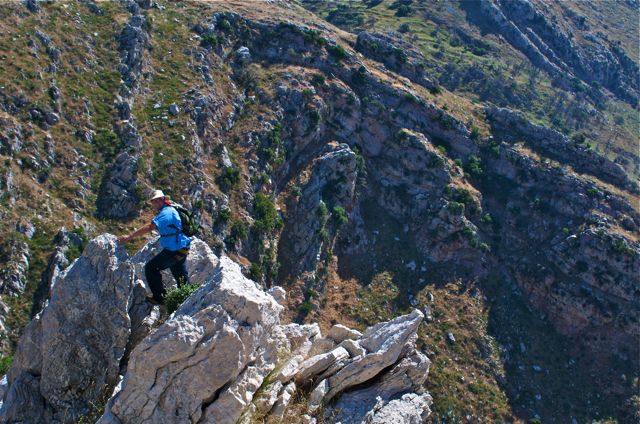
Karl Yares climbs on a fold
The geologists piece together the stratigraphy and history of Mt. Lykaion on a much grander scale than archaeologists, of course, detecting events that took place long before the first visitors to the ash altar, old as they are. But the remarkable geologic events of Mt. Lykaion are crucial to deciphering why the first people, when they came to the mountain, did what they did; building structures on a mountain, after all, is fundamentally an interaction of man and geology. Certain geologic features might have influenced the choice to establish a sanctuary in one mountainside meadow rather than another. Tectonic activity on the mountaintop might have contributed to the awe with which the ancients regarded the place. The geologists can also determine which rocks are native to the mountaintop and lower sanctuaries and which must have been carried from elsewhere by human hands. Over the course of this season and the next, George and Karl are excavating at the ash altar to expose the fault that runs across the mountaintop.
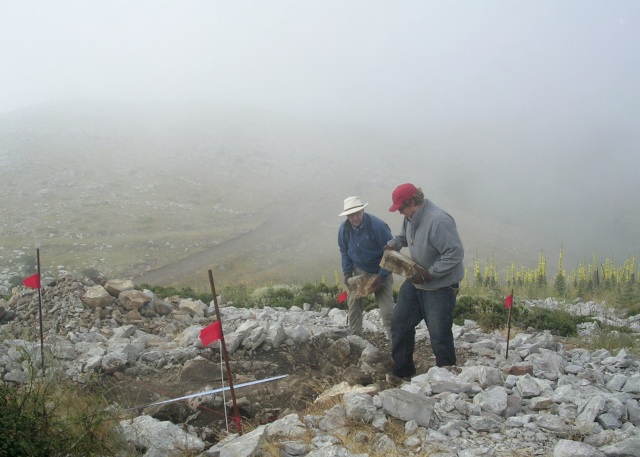
The geologists dig through the fog at their trench on the ash altar
George has also contributed to the project’s development of a proposal for the Parrhasian Heritage Park. Parrhasia, a name with Homeric roots (Il. 2.608, e.g.), refers to the area of southwestern Arcadia and beyond in which not only Mt. Lykaion but myriad other ancient cities and sanctuaries are located. Within the scope of the proposed park—which would span 300 square km in southern Elis and northern Messenia as well as in western Arcadia—fall many of the sites and scenes we’ve grown to love over the past weeks. There’s nearby Phigaleia, the city we visited in the second week of the excavation, which boasts not only the fountain house but a Temple of Athena.
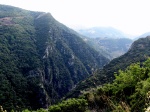
The Neda Gorge
Not far from the temple we could glimpse the Neda Gorge, with its breathtaking view straight to the Ionian Sea. On our Sunday excursion of the week, we visited three other important sites that fall within the proposed park: Lykosoura, Trapezus, and the city of Megalopolis. The city of Lykosoura, which Pausanias claimed to be “the oldest city in the world,” is notable for its Sanctuary of Despoina (a goddess related to Kore, a daughter of Demeter) and so-called Megaron complex. Trapezus, in the Megalopolitan plain, is thought to be one of the first Greek cities to be laid out on a grid; Megalopolis, one of the cities founded by Epaminondas after his victory at Leuctra, held the largest theatre in Greece, quite well-preserved to this day, a vast agora, and numerous temples.
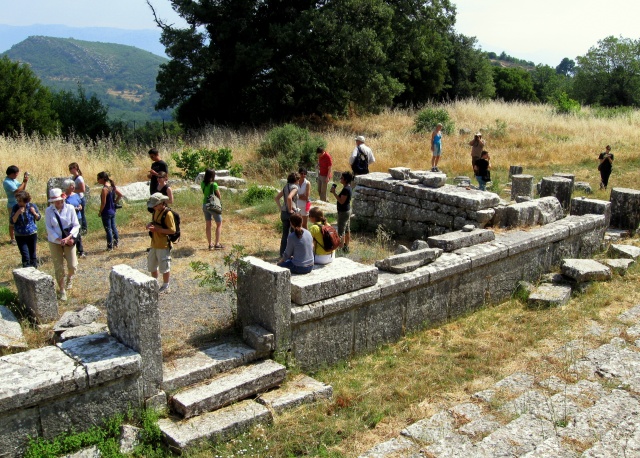
The group in the Temple of Despoina at Lykosoura
The region’s delights, though, are not only for classical archaeologists. There are many sites of more recent historical interest nearby, from the Frankish fortress at Karitaina to the many lovely Byzantine monasteries that pepper the landscape; on the other end of the spectrum, there are sites of paleological significance in the Megalopolitan plain.
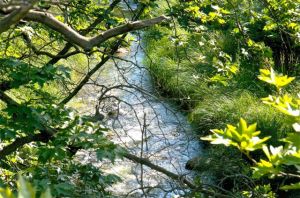
The Neda River, which flows through much of the region
But the area is also attractive simply for its natural beauty, with rugged mountains and rich forests, and for the glimpse it affords of traditional Greek life that is not to be found on the more touristed isles. The proposed park is designed to reflect this multiple heritage, then, not just one aspect of it. A visitor’s center would make information about the area available to tourists, while a series of paths and trails would allow travellers to enjoy more of the region on foot.
We have a great team working on the proposal; in addition to the project co-directors and George Davis, landscape architects Mark Davison and Danae Whipp, although they weren’t able to make it out this season, have been invaluable in spearheading the proposal and are now working on a brochure; Dr. Barbara Morehouse of the University of Arizona spent a week at Mt. Lykaion offering insight; Ximena Valle on the architecture team has been designing prototypes for informational signs to help guide visitors through the park. Perhaps most important, though, has been the support of the mayors and citizens of the towns that fall within the proposed park. Program co-directors David Romano and Mary Voyatzis went all the way to Athens on June 14th to speak about the park proposal at the War Museum for the meeting concerning the 10th re-enactment of the Modern Lykaion Games that will take place in August 2009. Their warm reception there and throughout augurs well for the park’s creation and, with it, more visitors to this wonderful corner of the Peloponnese.
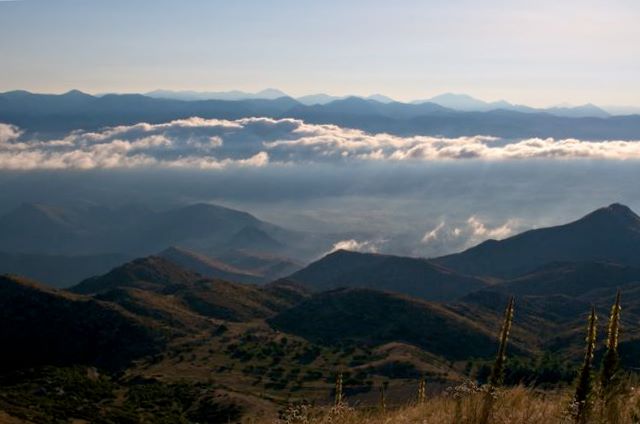
View from the Ash Altar
Spotlight on Architecture
The archaeology of the past century has seen a deepening
appreciation of the fact that excavation, even as it adds to our
knowledge of the past, destroys that past beyond recall. Unlike the
results of a scientific experiment, the results of excavation are
unrepeatable; no one will be able to dig the same trench again to see
if a previous excavator’s conclusions are valid. So, excavators need
to keep track of every step; a crucial part of this is the field
notebook, of course, with its exhaustive record of the digging
process, photographs, plans, and drawings. But even this may not
always be enough. The Mt. Lykaion project recognizes that, since this
record-keeping is just as important as the digging itself, it makes
sense for people trained specifically in documenting the actual state
of structures to be on site along with the excavators. That’s why we
have a team of architects.
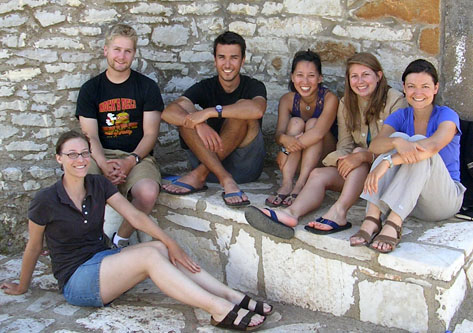
Our architects: (from left to right) Jess Bayuk, Erick Katzenstein, Gabe Burkett, Jenny Hong, Sarah Beth McKay, and Ximena Valle
This week, Ximena Valle, Assistant Field Director of Architecture,
delivered a wonderful lecture on to start off our evening lecture
series in which she explained to the rest of us how exactly the
architects do what they do. This week’s post will highlight the
architecture team and relate some of her insights.
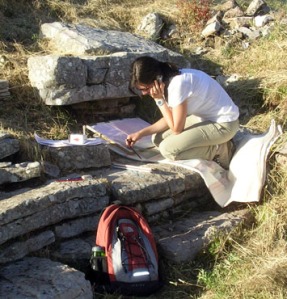
Ximena Valle working on the steps
Everyone on the project can see that the architects are never idle. They draw in the mornings, and in the afternoons, when most of us are working inside, in our lab, the architects usually head back to the hot field for another drawing session in the afternoon.
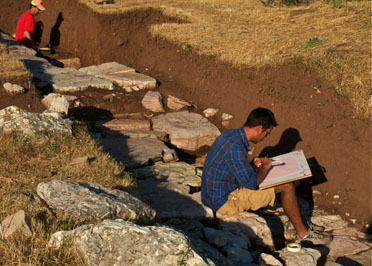
Gabe Burkett drawing slabs unearthed in the stoa
Then, when they aren’t in the field, they’re performing some complicated-looking operations on the computer. Ximena, who’s been with the project since 2006, explained to us what exactly they’re doing.
In the field, the architects have been drawing every visible structure at the site one block at a time. Each block is drawn twice, in plan and in elevation, at a 1:10 ratio, which can capture every detail of the blocks’ edges as well as cracks and limestone veins on the surface of the stone.
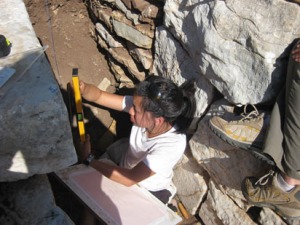
Jenny Hong at work in the fountain house
The drawings not only capture detail too minute for photographs, they also correct for the distortion of perspective inherent to photographs. Over the course of the past five field seasons, the architects have already completed the xenon, steps, and fountain house, as well as other blocks of architectural significance, such as the column bases in the temenos, and even “rubble blocks” that were once clearly part of a structure but have since fallen out of place. Now, they’re drawing the stoa and the bath house complex at the far end of the hippodrome. The architects also called in to help the excavators when blocks, column drums, and other architectural features are exposed in the trenches.
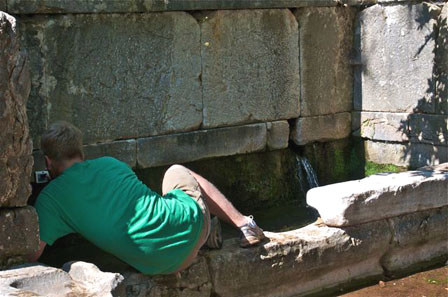
Erick Katzenstein photographing the fountain house at Phigaleia
In the lab, the architects gather together all the drawings they’ve produced—each done by a different hand, but each lining up exactly with the others—scan the drawings, and digitally stitch them together with Adobe Photoshop into a plan and elevation drawing of an entire structure. After some adjustments using Illustrator, points on the drawing are correlated with the topographical survey team’s geo-referenced points on AutoCAD. The result is a topographical map of the entire site which contains detail as minute as a fissure in a block.
The architects are also beginning to brainstorm possible reconstructions of the fountain house in Mt. Lykaion’s Lower Sanctuary.
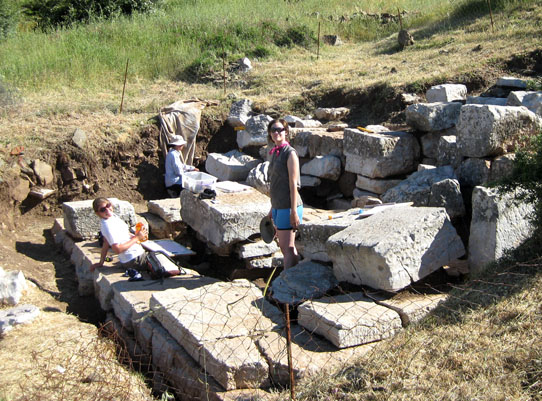
Sarah Beth McKay and Jess Bayuk at our fountain house
Everyone had fun participating in their field research for this project: last Saturday, we visited the nearby city of Phigalea, which contains the remains of a fountain house of a comparable age to the one at Mt. Lykaion. At the neighboring site of Lykosoura, too, much of a large fountain house remains intact; visiting this site also gave the architects ideas. We’re all excited to see what the architects will come up with and impressed by the team’s tireless dedication.
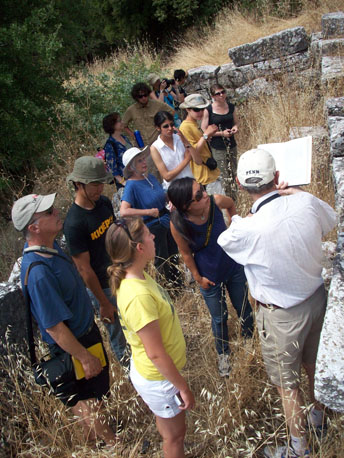
David Romano showing the group a reconstruction of the fountain house at Lykosoura
Start of Excavations: June 6-12
Our first few days of digging held a surprise for us: miserable weather. Those of us in the field had to contend with low temperatures, high winds, driving rain, and even occasional hail. Who thought we’d need to pack raincoats and polarfleeces for a summer in Greece? But there was probably a reason that Zeus the storm-god wasn’t known for his constancy.
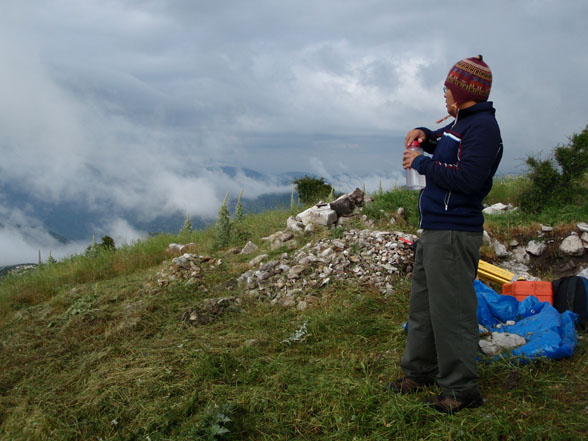
Arvey Basa bundles up at the Ash Altar
At the Ash Altar, where the wind can be fierce even on the sunniest of days, blowing ash and icy fingers made screening the soil difficult; gusts also posed a challenge for the survey team. In the Lower Sanctuary, where the trenches are deeper, the rain made for messy digging. We came through the first few days smiling, though, and the rain and cold soon gave way to the dry heat of a typical Greek summer.
By Sunday, the weather couldn’t have been more perfect for our first weekend excursion, a 2-hour hike from our site to the Temple of Apollo Epikourios at Bassae, visible from the top of the Ash Altar. When we arrived, project co-director Mary Voyatzis treated us to an overview of the site’s important features.
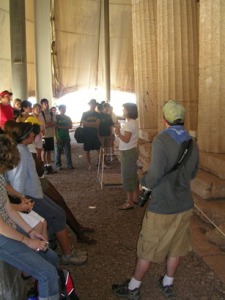
Dr. Mary Voyatzis talks to the group at the Temple of Apollo at Bassae
As Mary explained, the structure visible today, which is remarkably well preserved, dates from about 450 BC and was designed by Ictinus, one of the architects of the Parthenon. The temple stands out architecturally for many reasons, including its north-south orientation (most Greek temples run east to west) and the presence of all three major orders of column, Doric, Ionic, and even one Corinthian capital, the earliest known in Greece. The friezes from the temple, which depict the two famous battles of Greeks with Amazons and Lapiths with Centaurs, are now in the British Museum.
From Bassae, we continued by van to the seaside resort of Kalo Nero, where we enjoyed a Greek lunch of saganaki, calamari, and other traditional mezze (small plates). We ended our outing with a dip in the Ionian Sea.
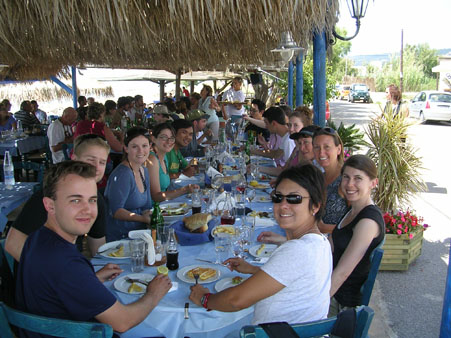
Lunch at the beach
Our workdays are long—we typically have breakfast at 6:15, leave for the site at 6:45, and return for lunch at 1:30, then work in the lab or return to the field in the afternoon—but we do manage to squeeze in some extra-archaeological activity. A running group, the Striders, is organized by co-director David Romano, who regularly competes in both the Penn Relays and in the Modern Lykaian Games, held in our site’s hippodrome. Three times a week, we meet for runs, often demanding given the high altitude and steep hills, but the views across Arcadia from the north face of Mt. Lykaion make the effort worthwhile.

View from the north face of Mt. Lykaion
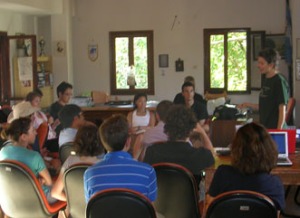
Nicky Pasterfield giving a Greek lesson
In the evenings, Nicky Pasterfield has been offering a series of Modern Greek lessons, equipping us with the phrases we need to greet the residents of our village courteously and to get along during our shopping and dining excursions to Megalopolis. On some evenings, we even find time to unwind on the village plateia with a drink and a backgammon board.
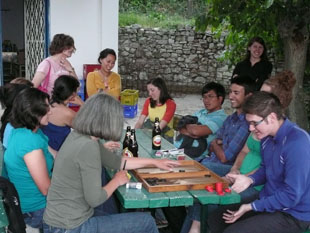
Relaxing on the Ano Karyes plateia
Arrival in Greece: June 1-5, 2009
In the first few days of any field season, it’s always a little strange to relinquish all our other roles in life—as students, parents, programmers, professors, retirees, geologists, historians, linguists, philosophers—and turn into full-time archaeologists. But so far this year the transition has been remarkably seamless. Things began on the right foot: no delayed flights, no lost luggage, and a peaceful drive from Athens to Arcadia.

Goats and sheep welcome our van
Many familiar sights and faces greeted those of us returning to Mount Lykaion: herds of goats in the road, commanding views across the mountains, the village plateia and Kyria Eleni, owner of the little shop there. But some things are different, and they bode well for the season’s success. Our IT manager, Michael Tseng, set up a wireless internet connection on the very first day; the modern setup is a remarkable achievement considering our remote location.
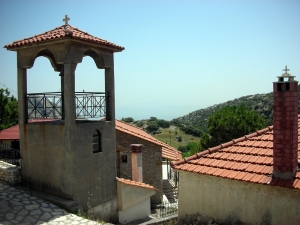
Ano Karyes, one of the villages where we live during the field season
We have a new cook, Sam McBride, a new house manager, Nancy Mueller, and, for the first time, a field operations manager, Tom Keating. Adventures with electricity and plumbing have already made it clear what a tremendous boon it will be to have such capable hands in charge of the project’s nuts and bolts. We’re also here three weeks earlier in the year, since in August, when our season usually ends, the modern Lykaian games will be held at the site. It’s a much more temperate time of year; the mountain slopes are greener, and there are wildflowers everywhere.
Our first day was taken up by unpacking and touring the site, which consists of two separate sanctuaries. The Lower Sanctuary is where the Lykaian games were (and continue to be) held; it contains a hippodrome and stadium, steps, which may have functioned as seats, a stoa of considerable length, a large building which probably was used for administrative purposes, a fountain house, and a bath house. The Upper Sanctuary, 200 m further up and 400 m away, sits at the mountaintop itself.
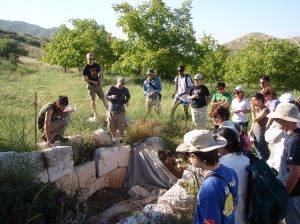
Tour of the Lower Sanctuary
Mt. Lykaion has two peaks, the taller north peak, and the south peak, which has the ash altar to Zeus and the temenos at the top. At an elevation of more than 4500 feet, we were all probably glad it wasn’t any taller by the time we’d climbed to the top, and the view is still spectacular. From the altar is visible, not only the Lower Sanctuary, but Cretea, the region of Mount Lykaion which, as readers of Callimachus’ Hymn to Zeus know, one tradition claims to be the birthplace of the king of gods. We can also see the white tent that covers the temple of Apollo Epikourios at Bassae, the snow-capped Mount Taygetus, and, on a very clear day, all the way to Kalamata in the south, Zakynthos in the northwest, and the Ionian Sea.
But by now even vistas such as these are becoming familiar; we’re each settling into our respective routines and getting ready for a busy six weeks of archaeology.
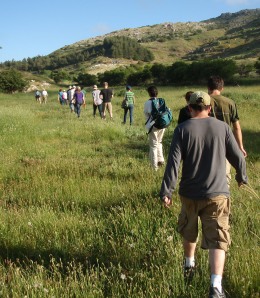
The 2009 weblog of the Mt. Lykaion Excavation and Survey Project is compiled by Maya Gupta, member of the excavation staff at Mt. Lykaion. Maya, returning for her third season with the project, is a graduate of the University of Pennsylvania (C ’08) and a Ph.D. student at Yale University.
Week 4: July 16-22, 2007

George Davis presenting his geological research in the Dining Palace.
George Davis gives a presentation of the results of his geological survey during the 2007 summer in the Dining Palace. The presentation features a number of new color and computer generated geological maps of the area of the southern peak of Mt. Lykaion that represent the results of three summers’ activity of Dr. Davis at Mt. Lykaion. He has been researching the structural nature of the southern peak of the mountain with specific interest in the location of the geological faults in the area.
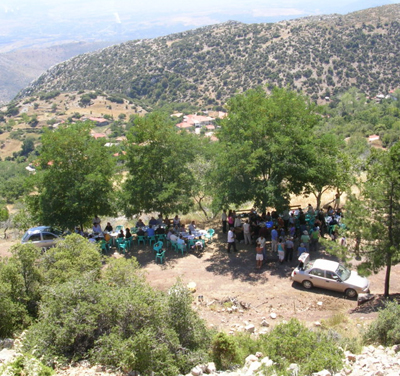
Agios Elias festival
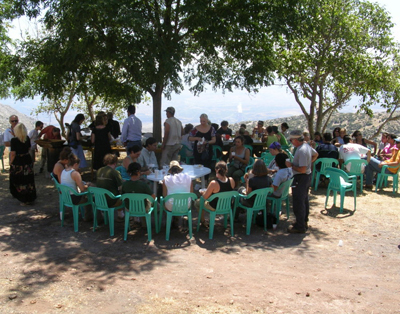
Agios Elias festival
We celebrate the Agios Elias festival on Friday July 20 by joining the villagers who have prepared boiled (old) goat for lunch at the Lykaia Fountain on the east slope of Mt. Lykaion. The church of Agios Elias is close to the temenos near the southern peak of the mountain and there is a church service there in the morning before the luncheon. This is a very festive occasion and we enjoy the lunch and the company. Villagers and their relatives come from different parts of Greece to attend this gathering. We are delighted to be invited to this festival and to take part in the festivities.
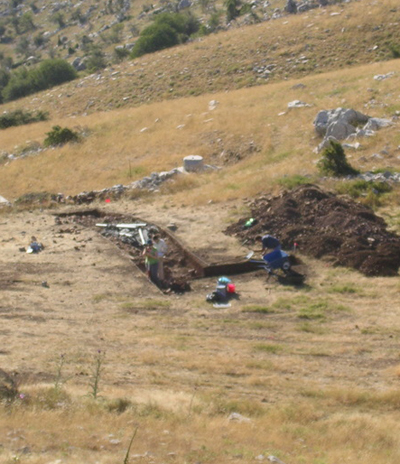
Work continues and is expanded in the temenos under the supervision of Alexis Belis and Josh Gieske.
Work continues in the trenches at the ash altar and temenos as well as the trenches in the lower sanctuary.
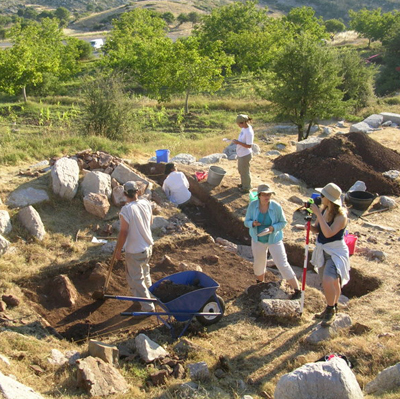
Work continues in the area of the ‘xenona’ under the supervision of Christina Gieske and Maya Gupta.
The pottery is washed in the courtyard in front of the Cultural Center of the village under the supervision of Dr. Leslie Hammond and the washed pottery dries in the screens. We are finding a good deal of interesting pottery this year and we are excited by the quality of the material. Several ceramic specialists have come through to visit the excavation and have confirmed that we have been finding a good deal of early pottery in the fill of the ash altar, including early Bronze Age material. This is very interesting for us as it pushes back the date of the earliest material from the altar (as reported by Kourouniotes) from the 8th century B.C. to much earlier.
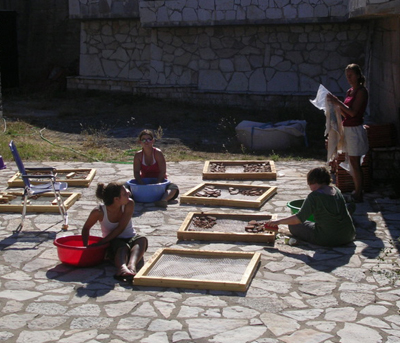
Pottery washing and drying in the courtyard in front of the Cultural Center, Leslie Hammond in charge (standing far right). Left to right seated, Rachel Moskowitz, Sarah Linn and Diane Amoroso O’Connor.
Yanis Pikoulas of the University of Thessaly and his team of three students are with us over the weekend. They have as their principle mission the identification of a historical site near the Alpheios river.
Saturday morning we have visits from Jack Davis, the new Director of the American School of Classical Studies at Athens and his wife Shari Stocker together with Mary Sturgeon and niece Kelly. On Sunday morning we have a visit from Jim Wright, Mary Dabney and son Niko from Nemea.
Our Sunday excursion (for those interested) is to Olympia (again) where we know that the guards are no longer on strike. This provides us with a chance to visit the Museum and the Archaeological Site. We also have the opportunity for a late lunch and a beach visit on the Ionian Sea.
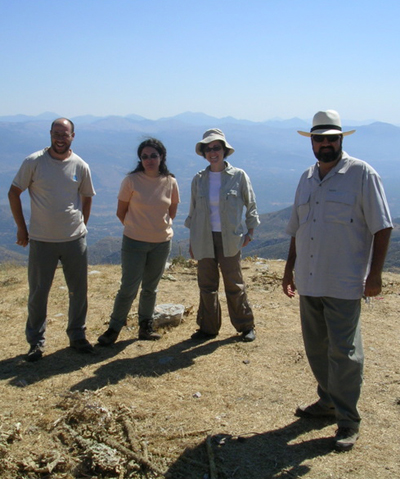
Yanis Pikoulas and students at the altar
Week 3: July 9 – 15
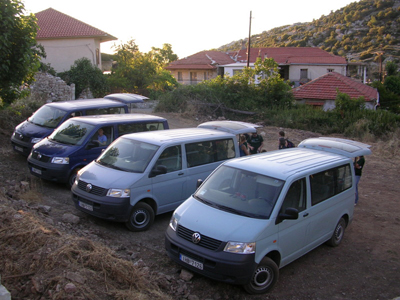
Typical morning scene at 6:45 am packing up the four vans with the equipment for the day. The trip from Ano Karyes to the lower sanctuary takes about 10 minutes by car and to the upper site takes about 20 minutes.
Our colleague from the Tripolis Ephoreia, Vassilis Papadopoulos, arrives and opens the two trenches that will be supervised by the Greek Archaeological Service, one in the area above the seats in the lower sanctuary and the other in the area of the temenos near the altar. Several workmen from the Greek Archaeological Service are added to the work force.
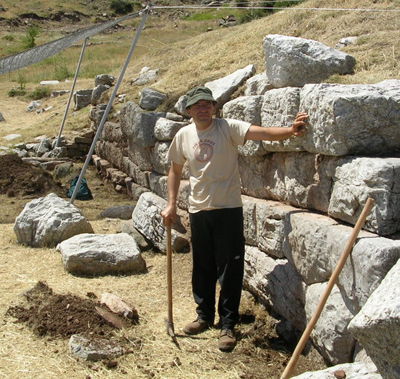
Workman Thanassis Christeas cleaning the area in front of the “xenon” wall.
Mark Davison presents an update on his work on the subject of the Archaeological Park proposal. He and Danae Whipp have been gathering data again this summer relating to the use of the area of Mt. Lykaion in the planning of the larger park. We are expecting the visit of our colleague Professor Costas Cassios from the National Polytechnic University who is instrumental in our planning process.
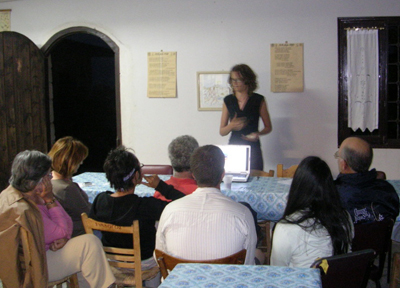
Pam Jordan presenting her Masters thesis work.
Pam Jordan gives a presentation on the subject of her Master’s thesis at the University of Pennsylvania considering the possible planning theory of the site of the Sanctuary of Zeus at Mt. Lykaion.
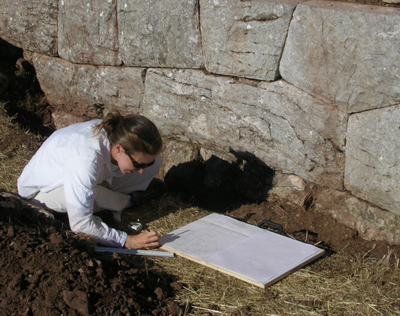
Reagan Ruedig working on the drawing of the Xenon wall.
The topographical and Survey work continues under the direction of Andrew Insua.
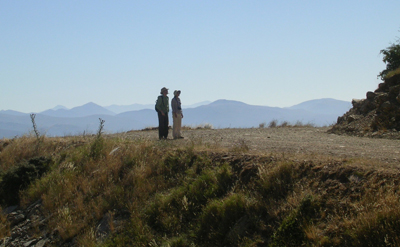
Mark Davison and Danae Whipp contemplating the landscape.
The long weekend for the students include Friday afternoon, Saturday and Sunday. Many students take the bus to Nauplion while others go to Athens and some to nearby islands. I stay in Ano Karyes together with a number of others and spend much of Saturday on a shopping expedition to Tripolis.

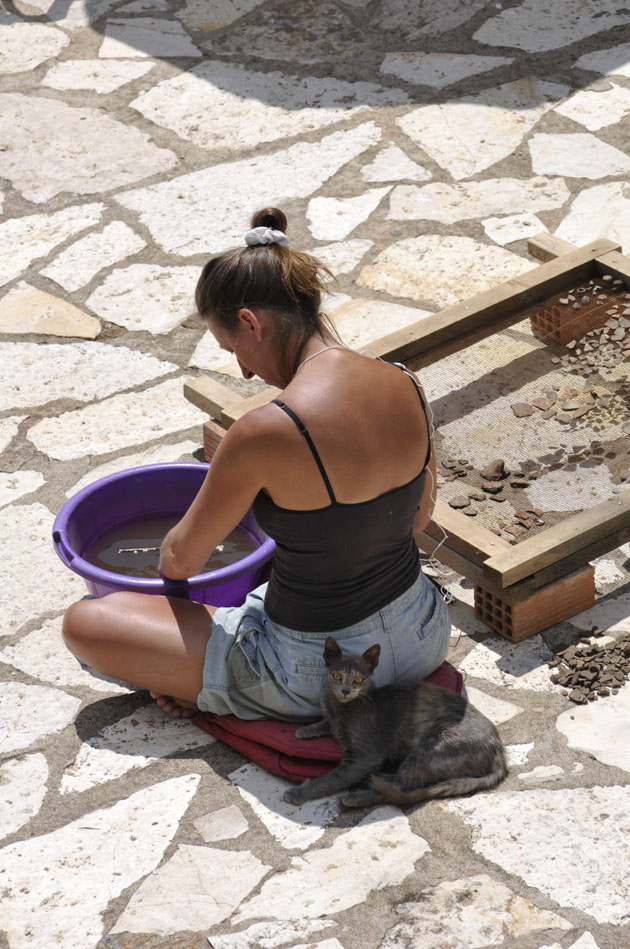
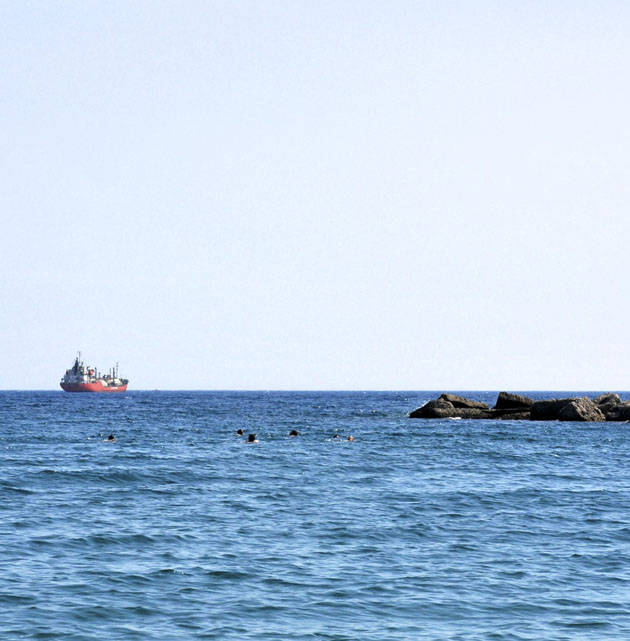
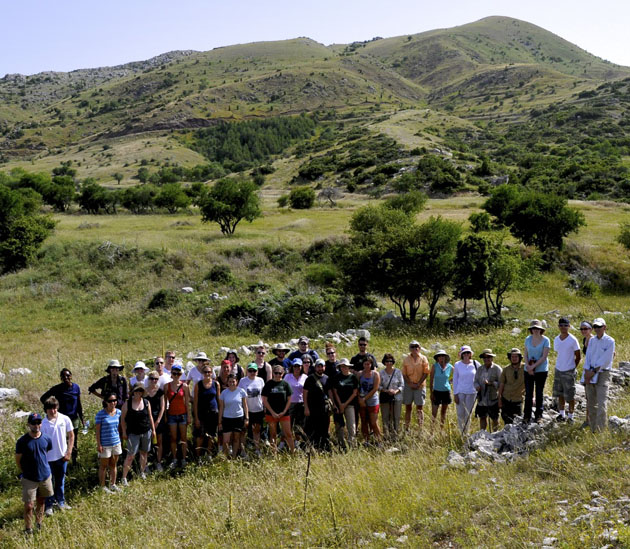
You must be logged in to post a comment.